Hello!
I've searched the other threads and didn't see anything similar so I'm posting here. I have two pearl necklaces that I've inherited and need some help identifying them. I know little to nothing about jewelry. I've spent hours trying to research online and couldn't find anything similar. Any help is so appreciated as these are from my husbands late, estranged great grandmother.
Some clues:
Set A: (I suspect is imitation)
31" Long folded in half. (So clasped, and measured length as if you were wearing it.) 167 pearls in total.
Knots in between pearls.
Feels smooth when rubbing two pearls against each other.
Most are quite yellowed but not all.
Generally most of them are pretty round
Pretty basic looking clasp, gold colored with wear, no markings of any kind to indicate material, spec or brand.
Set B:
18" Long in total (not folded in half, the clasp is broken.) 103 pearls in total.
No Knots in between pearls, but I suspect this has been re-strung possibly due to the broken clasp and the amount of times it looks to have been tied back on.
Feels gritty when rubbing two pearls against each other.
Most are on the 'whiter' side with a warm undertone.
Graduated Pearls in size. Most are kind of 'off shaped' when you look closely at them but overall round. Some have small pits.
Very intricate clasp that I cannot seem to find any that look just like this one. It looks similar to Mikimoto clasp, but not exactly. There is also no Mikimoto stamp on the back. The back of the clasp simply says 'silver'. She did have two sets of Mikimoto pearl earrings in a box so it wouldn't be too far off for her to have a necklace as well but without the mark/unknotted I'm hesitant to say.
Thank you for reading.
I've searched the other threads and didn't see anything similar so I'm posting here. I have two pearl necklaces that I've inherited and need some help identifying them. I know little to nothing about jewelry. I've spent hours trying to research online and couldn't find anything similar. Any help is so appreciated as these are from my husbands late, estranged great grandmother.
Some clues:
- The box I received them in says "Marmod-Jaccard-King Jewelry co." Both sets were in the same box. No paperwork or any other identifying items were with them. This might not be their box.
- These were his great grandmother so, I would assume she got them any where between 1920-1950?? Possibly even earlier if she had also inherited them. I am not totally sure about age on this, we weren't close with her so it's really hard to gauge. I'm not even sure how old she was when she passed, that would really tell me though. I'm just guessing based on other grandparents that might have been aged similarly.
- I've left both of these in the same area/temperature for a few hours and set a is cool, but set b is much cooler.
- I don't have a magnifying anything aside from my phone camera, if it comes down to a tie I can order one. I also didn't do the acetone test, save that for last since it could be destructive. I also want to note, I have not cleaned these in any way, as I'm not entirely sure how to do so without potentially damaging them.
Set A: (I suspect is imitation)
31" Long folded in half. (So clasped, and measured length as if you were wearing it.) 167 pearls in total.
Knots in between pearls.
Feels smooth when rubbing two pearls against each other.
Most are quite yellowed but not all.
Generally most of them are pretty round
Pretty basic looking clasp, gold colored with wear, no markings of any kind to indicate material, spec or brand.
Set B:
18" Long in total (not folded in half, the clasp is broken.) 103 pearls in total.
No Knots in between pearls, but I suspect this has been re-strung possibly due to the broken clasp and the amount of times it looks to have been tied back on.
Feels gritty when rubbing two pearls against each other.
Most are on the 'whiter' side with a warm undertone.
Graduated Pearls in size. Most are kind of 'off shaped' when you look closely at them but overall round. Some have small pits.
Very intricate clasp that I cannot seem to find any that look just like this one. It looks similar to Mikimoto clasp, but not exactly. There is also no Mikimoto stamp on the back. The back of the clasp simply says 'silver'. She did have two sets of Mikimoto pearl earrings in a box so it wouldn't be too far off for her to have a necklace as well but without the mark/unknotted I'm hesitant to say.
Thank you for reading.
Attachments
-
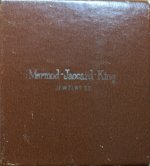 1000002062.jpg348.6 KB · Views: 303
1000002062.jpg348.6 KB · Views: 303 -
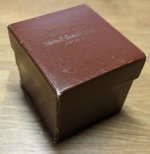 1000002063.jpg202.7 KB · Views: 290
1000002063.jpg202.7 KB · Views: 290 -
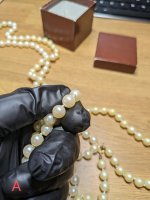 1000002064.jpg420.1 KB · Views: 310
1000002064.jpg420.1 KB · Views: 310 -
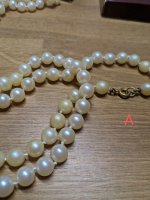 1000002065.jpg725 KB · Views: 338
1000002065.jpg725 KB · Views: 338 -
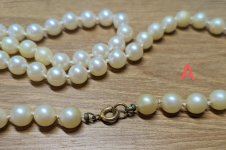 1000002066.jpg525.7 KB · Views: 328
1000002066.jpg525.7 KB · Views: 328 -
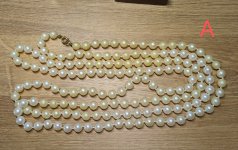 1000002067.jpg826 KB · Views: 326
1000002067.jpg826 KB · Views: 326 -
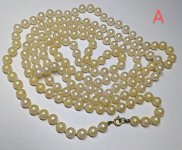 1000002071.jpg338.1 KB · Views: 309
1000002071.jpg338.1 KB · Views: 309 -
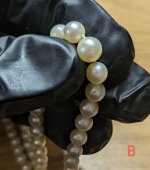 1000002056.jpg102.7 KB · Views: 325
1000002056.jpg102.7 KB · Views: 325 -
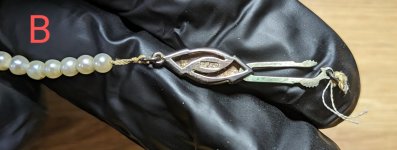 1000002057.jpg151.1 KB · Views: 308
1000002057.jpg151.1 KB · Views: 308 -
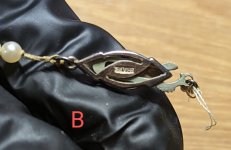 1000002058.jpg62.1 KB · Views: 320
1000002058.jpg62.1 KB · Views: 320 -
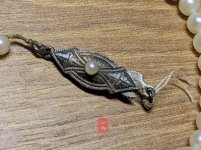 1000002059.jpg155.6 KB · Views: 337
1000002059.jpg155.6 KB · Views: 337 -
 1000002061.jpg577.2 KB · Views: 360
1000002061.jpg577.2 KB · Views: 360 -
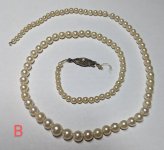 1000002072.jpg234.9 KB · Views: 370
1000002072.jpg234.9 KB · Views: 370
